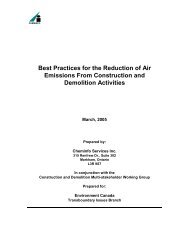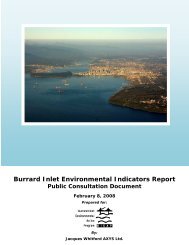Dredge Management Guidelines - the BIEAP and FREMP Website
Dredge Management Guidelines - the BIEAP and FREMP Website
Dredge Management Guidelines - the BIEAP and FREMP Website
Create successful ePaper yourself
Turn your PDF publications into a flip-book with our unique Google optimized e-Paper software.
Appendix 2<br />
6 The “lower Fraser River<br />
Estuary” is defined as <strong>the</strong><br />
section of <strong>the</strong> Fraser River<br />
from <strong>the</strong> Oak Street Bridge<br />
<strong>and</strong> George Massey Tunnel<br />
downstream to Roberts<br />
<strong>and</strong> Sturgeon Banks<br />
(exclusive).<br />
Appendix 2<br />
Environmental Dredging <strong>Guidelines</strong> for <strong>the</strong> Lower Fraser<br />
(source: <strong>FREMP</strong>)<br />
1 From March 1 to March 15, <strong>the</strong>re shall be no suction dredging in water which is less than five (5)<br />
metres deep at daily low water in order to protect juvenile salmonids.<br />
2 From March 15 to June 15, <strong>the</strong>re shall be no dredging (clamshell or suction) of dredge material volumes<br />
greater than 4000 m3 in order to protect eulachon.<br />
3 From June 15 to July 15, in <strong>the</strong> lower Fraser River Estuary 6<br />
, <strong>the</strong>re shall be no suction dredging in<br />
water which is less than five (5) metres deep at daily low water in order to protect juvenile<br />
salmonids.<br />
4 Pumps for suction dredging shall not operate when <strong>the</strong> suction-head is within one <strong>and</strong> one half<br />
metres (1.5 m) of <strong>the</strong> bottom.<br />
5 If <strong>the</strong> dredge material is intended for ocean or in-river disposal, <strong>the</strong> dredge spoil must comply with<br />
Environment Canada’s Ocean Disposal Regulations <strong>and</strong> Interim Contaminant Testing <strong>Guidelines</strong><br />
found in Appendix 5 of <strong>the</strong>se <strong>Guidelines</strong>. If upl<strong>and</strong> disposal is planned, <strong>the</strong> dredge material must<br />
comply with <strong>the</strong> provincial Ministry of Environment, L<strong>and</strong>s <strong>and</strong> Parks’ Contaminated Sites<br />
Regulation under <strong>the</strong> Waste <strong>Management</strong> Act. These are found in Appendix 3 of <strong>the</strong>se <strong>Guidelines</strong>.<br />
6 The works shall be conducted utilizing water-based machinery or equipment (e.g. boat, barge, etc.)<br />
which shall be firmly moored in deep water, far enough offshore to prevent any grounding onto <strong>the</strong><br />
intertidal foreshore or riverbed of <strong>the</strong> Fraser River. The only exception is <strong>the</strong> use of vertical spuds or<br />
o<strong>the</strong>r anchors to keep <strong>the</strong> machinery or equipment firmly moored in place.<br />
7 All works <strong>and</strong> activities riverward of higher high water, including works on <strong>the</strong> foreshore conducted<br />
in <strong>the</strong> dry during periods of low water, works in, over or adjacent to <strong>the</strong> water or works discharging<br />
to <strong>the</strong> water shall be conducted in a manner that prevents or minimizes <strong>the</strong> direct or indirect release<br />
of sediment or sediment-laden water into <strong>the</strong> aquatic environment. In this regard, <strong>the</strong> works should<br />
address <strong>the</strong> applicable water quality criteria as described in <strong>the</strong> British Columbia Water Quality<br />
<strong>Guidelines</strong> (Criteria): 1998 Edition produced by BC Ministry of Environment, L<strong>and</strong>s <strong>and</strong> Parks (<strong>the</strong><br />
“water quality criteria). For particulate matter, <strong>the</strong> water quality criteria includes <strong>the</strong> following specific<br />
criteria:<br />
i When background is less than or equal to 50 nephelometric turbidity units (NTU), induced turbidity<br />
should not exceed 5 NTU above <strong>the</strong> background value.<br />
ii When background is greater than 50 NTU, induced turbidity should not exceed <strong>the</strong> background<br />
value by more than 10 % of <strong>the</strong> background value.<br />
iii When background is less than or equal to 100 milligrams per litre (mg/L), induced non-filterable<br />
residue (NFR) should not exceed 10 mg/L above <strong>the</strong> background value.<br />
iv When background is greater than 100 mg/L, induced NFR should not exceed <strong>the</strong> background<br />
value by more than 10 % of <strong>the</strong> background value.<br />
For <strong>the</strong> purposes of <strong>the</strong>se guidelines, background is defined as <strong>the</strong> level at an appropriate adjacent<br />
reference site that is affected nei<strong>the</strong>r by works at <strong>the</strong> site, nor sediment-laden or turbid waters<br />
resulting from works at <strong>the</strong> site.<br />
Should <strong>the</strong> works result in NTU or NFR levels in excess of <strong>the</strong> criteria outlined above, <strong>the</strong>n those<br />
works <strong>and</strong> activities that might be contributing to <strong>the</strong> turbidity shall be halted until measures are<br />
put in place to ensure compliance.<br />
41 Appendix 2
















